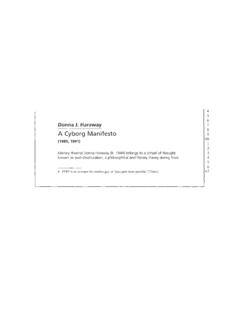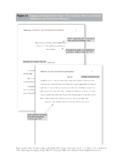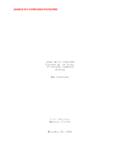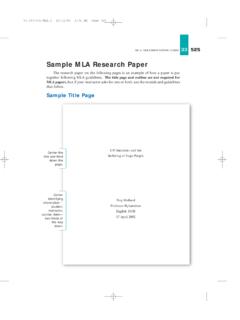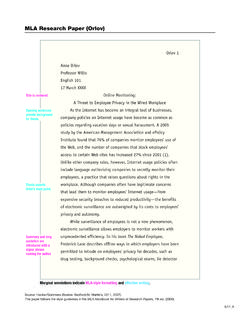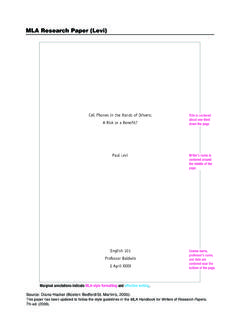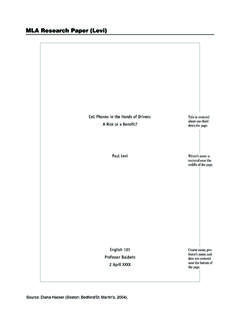Transcription of MLA Literature Paper (Larson)
1 Source: Diana Hacker (Boston: Bedford/St. Martin s, 2002). larson 1 Dan LarsonProfessor DuncanEnglish 10216 April XXXXThe Transformation of Mrs. Peters:An Analysis of A Jury of Her Peers In Susan Glaspell s 1917 short story A Jury of Her Peers, two women accompany their husbands and a county attorney to anisolated house where a farmer named John Wright has been chokedto death in his bed with a rope. The chief suspect, Wright s wifeMinnie, is in jail awaiting trial. The sheriff s wife, Mrs. Peters, hascome along to gather some personal items for Minnie, and has joined her. Early in the story, Mrs. Hale sympathizes withMinnie and objects to the way the male investigators are snoopin round and criticizin her kitchen (293). In contrast, Mrs. Petersshows respect for the law, saying that the men are doing no morethan their duty (293). By the end of the story, however, has joined Mrs. Hale in a conspiracy of silence, lied to themen, and committed a crime--hiding key evidence.
2 What causesthis dramatic change?One critic, Leonard Mustazza, argues that Mrs. Hale recruitsMrs. Peters as a fellow juror in the case, moving the sheriff s wifeaway from her sympathy for her husband s position and towardsidentification with the accused woman (494). While this is true,Mrs. Peters also reaches insights on her own. Her observations inthe kitchen lead her to understand Minnie s grim and lonely plightas the wife of an abusive farmer, and her identification with bothThe opening linesname the story andestablish opening para-graph ends withLarson s from asecondary source:author is named in asignal phrase; pagenumber is given tense isused to describe de-tails from the fromthe story are citedwith page numbersin thesis assertsLarson s main Literature Paper ( larson )Title is : Diana Hacker (Boston: Bedford/St. Martin s, 2002). larson 2 Minnie and Mrs. Hale is strengthened as the men conducting theinvestigation trivialize the lives of first evidence that Mrs.
3 Peters reaches understanding onher own surfaces in the following passage:The sheriff s wife had looked from the stove to the sink--to the pail of water which had been carried in from out-side.. That look of seeing into things, of seeingthrough a thing to something else, was in the eyes ofthe sheriff s wife now. (295)Something about the stove, the sink, and the pail of water con-nects with her own experience, giving Mrs. Peters a glimpse intothe life of Minnie Wright. The details resonate with historian Elaine Hedges argues that such details, whichevoke the drudgery of a farm woman s work, would not have beenlost upon Glaspell s readers in 1917. Hedges tells us what the pailand the stove, along with another detail from the story--a dirtytowel on a roller--would have meant to women of the was a dreaded all-day affair. Water had to be pumped,hauled, and boiled; then the wash was rubbed, rinsed, wrungthrough a wringer, carried outside, and hung on a line to dry.
4 What the women see, beyond the pail and the stove, writes Hedges, are the hours of work it took Minnie to producethat one clean towel (56).On her own, Mrs. Peters discovers clues about the motive forthe murder. Her curiosity leads her to pick up a sewing basket filled with quilt pieces and then to notice somethingstrange: a sudden row of badly sewn stitches. What do you A long quotation isset off by indenting;no quotation marksare needed; ellipsisdots indicate a sen-tence omitted fromthe summarizesideas from a sec-ondary source andthen quotes fromthat source; henames the authorin a signal phraseand gives a pagenumber in sentencefocuses on larson : Diana Hacker (Boston: Bedford/St. Martin s, 2002). larson 3suppose she was so--nervous about? asks Mrs. Peters (296).Ashort time later, Mrs. Peters spots another clue, an empty she observes details on her own, in this case a broken doorand hinge, suggesting that the cage has been roughly addition to noticing details, both women draw conclusionsfrom them and speculate on their significance.
5 When Mrs. Halefinds the dead canary beneath a quilt patch, for example, thewomen conclude that its neck has been wrung and understand whomust have wrung the women speculate on the significance of the deadcanary, each connects the bird with her own experience. Mrs. Haleknows that Minnie once sang in the church choir, an activity thatMr. Wright put a stop to, just as he put a stop to the bird ssinging. Also, as a farmer s wife, Mrs. Hale understands the deso-lation and loneliness of life on the prairie. She sees that the birdwas both a thing of beauty and a companion. If there had beenyears and years of--nothing, then a bird to sing to you, says , it would be awful--still--after the bird was still (300). ToMrs. Peters, the stillness of the canary evokes memories of thetime when she and her husband homesteaded in the northernplains. I know what stillness is, she says, as she recalls thedeath of her first child, with no one around to console her (300).
6 Elaine Hedges has written movingly of the isolation thatwomen experienced on late-nineteenth- and early-twentieth-cen-tury farms of the West and Midwest:Women themselves reported that it was not unusual tospend five months in a log cabin without seeing Topic sentencesfocus on interpre-tation, not just from thestory provideevidence for : Diana Hacker (Boston: Bedford/St. Martin s, 2002). larson 4another woman .. or to spend one and a half yearsafter arriving before being able to take a trip to town.. (54)To combat loneliness and monotony, says Hedges, many womenbought canaries and hung the cages outside their sod huts. The ca-naries provided music and color, a spot of beauty that might spellthe difference between sanity and madness (60).Mrs. Peters and Mrs. Hale understand--and Glaspell s readersin 1917 would have understood--what the killing of the bird meansto Minnie. For Mrs. Peters, in fact, the act has a special signifi-cance. When she was a child, a boy axed her kitten to death and,as she says, If they hadn t held me back I would have.
7 Hurthim (300). She has little difficulty comprehending Minnie s mur-derous rage, for she has felt it Mrs. Peters s growing empathy for Minnie stemslargely from her observations, it is also prompted by her negativereaction to the patronizing comments of the male investigators. Atseveral points in the story, her body language reveals her example, when Mr. Hale remarks that women are used to wor-rying over trifles, both women move closer together and remainsilent. When the county attorney asks, for all their worries, whatwould we do without the ladies? the women do not speak, nor dothey unbend (291). The fact that the women respond in exactlythe same way reveals the extent to which they are women are annoyed at the way in which the men criti-cize and trivialize the world of women. The men question thedifficulty of women s work. For example, when the county attorneyTransition servesas a bridge fromone section of thepaper to the dots indi-cate omitted wordswithin the sentenceand at the end ofthe : Diana Hacker (Boston: Bedford/St.)
8 Martin s, 2002). larson 5points to the dirty towel on the rack as evidence that Minniewasn t much of a housekeeper, Mrs. Hale replies, There s a greatdeal of work to be done on a farm (291). Even the importance ofwomen s work is questioned. The men kid the women for trying todecide if Minnie was going to quilt or knot patches together for aquilt and laugh about such trivial concerns. Those very quilts, ofcourse, kept the men warm at night and cost them nothing beyondthe price of men also question the women s wisdom and example, when the county attorney tells the women to keeptheir eyes out for clues, Mr. Hale replies, But would the womenknow a clue if they did come upon it? (292). The women sresponse is to stand motionless and silent. The irony is that themen don t see the household clues that are right in front of the end of the story, Mrs. Peters has been so transformedthat she risks lying to the men. When the district attorney walksinto the kitchen and notices the birdcage the women have found,he asks about the whereabouts of the bird.
9 Mrs. Hale replies, Wethink the cat got it, even though she knows from Mrs. Petersthat Minnie was afraid of cats and would not have owned of correcting the lie, Mrs. Peters elaborates on it, sayingof cats, They re superstitious, you know; they leave (299).Clearly Mrs. Hale is willing to risk lying because she is confidentthat Mrs. Peters won t contradict Mrs. Peters character may have been based on a realsheriff s wife. Seventeen years before writing A Jury of Her Peers, Susan Glaspell covered a murder case for the givesevidence that has draws on a secondary sourcethat gives back-ground on Glaspell : Diana Hacker (Boston: Bedford/St. Martin s, 2002). larson 6A farmer s wife, Margaret Hossack, was accused of murdering hersleeping husband with two axe blows to the head. In one of hernewspaper reports, Glaspell wrote that the sheriff s wife sat next toMrs. Hossack and frequently applied her handkerchief to her eyes (qtd. in Ben-Zvi 30).We do not know from the short story the ultimate fate ofMinnie Wright, but Margaret Hossack, whose case inspired the story,was found guilty, though the case was later thrown out by the IowaSupreme Court.
10 However, as Linda Ben-Zvi points out, the women sguilt or innocence is not the issue:Whether Margaret Hossack or Minnie Wright committedmurder is moot; what is incontrovertible is the brutality oftheir lives, the lack of options they had to redress griev-ances or to escape abusive husbands, and the completedisregard of their plight by the courts and by society. (38)These are the issues that Susan Glaspell wished to stress in A Juryof Her Peers. These are also the issues that Mrs. Peters comes to understandas the story unfolds, with her understanding deepening as sheidentifies with Minnie and Mrs. Hale and is repulsed by male atti-tudes. Her transformation becomes complete when the men jokethat she is married to the law and she responds by violating thelaw: hiding key evidence, the dead s conclusionechoes his mainpoint without dully repeating : Diana Hacker (Boston: Bedford/St. Martin s, 2002). larson 7 Works CitedBen-Zvi, Linda. Murder, She Wrote : The Genesis of SusanGlaspell s Trifles.
